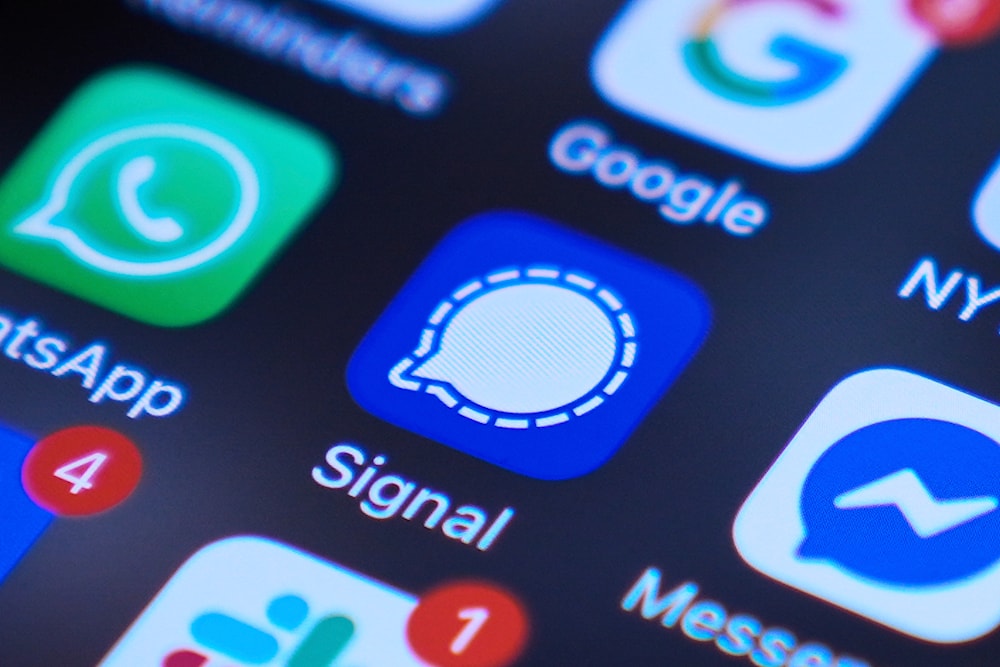The Atlantic publishes attack plans shared by Trump's advisors
The Atlantic made the call to publish the contents of the group chat after several US officials accused the magazine of "lying", in a bid to allow people to "reach their own conclusions."
-

Signal app on a smartphone is seen on a mobile device screen Tuesday, March 25, 2025, in Chicago (AP)
The Atlantic shared on Wednesday the attack plans accidentally leaked by the Trump administration to the American magazine's editor-in-chief Jeffrey Goldberg, who was added by mistake to a group chat on the Signal messaging app.
Michael Waltz, the National Security Advisor of the United States, accidentally added the editor-in-chief of The Atlantic to the group chat named "Houthi PC small group," where top US officials, including US Vice President JD Vance, were discussing US military operations against Yemen.
Much of the conversation in the "Houthi PC small group" focused on the timing and rationale behind attacks on the Houthis, including remarks by Trump administration officials about the perceived shortcomings of America's European allies.
Contents of the chat
At 11:44 a.m. Eastern Time, Hegseth posted in the chat, in all caps, "TEAM UPDATE:"
The message continued with important details: "TIME NOW (1144ET): Weather is FAVORABLE. Just CONFIRMED w/CENTCOM we are a GO for mission launch." CENTCOM, or Central Command, is the military’s combatant command overseeing operations in the Middle East.
The update progressed with a timeline of actions. "1215ET: F-18s LAUNCH (1st strike package)." Then, at 1:45 p.m., the message stated: "1345: ‘Trigger Based’ F-18 1st Strike Window Starts. Target Terrorist is at his known location, so we SHOULD BE ON TIME." The post also confirmed the launch of strike drones: "Strike Drones Launch (MQ-9s)."
The update continued with more mission details: "1410: More F-18s LAUNCH (2nd strike package)." At 2:15 p.m., the message stated: "Strike Drones on Target (THIS IS WHEN THE FIRST BOMBS WILL DEFINITELY DROP, pending earlier ‘Trigger Based’ targets)."
By 3:36 p.m., the second strike from the F-18s began, along with the launch of the first sea-based Tomahawks. The message concluded with, "MORE TO FOLLOW (per timeline)" and assured, "We are currently clean on OPSEC," meaning operational security was intact. The final words were a message of support: "Godspeed to our Warriors."
At 1:48 p.m., Waltz sent a text with real-time intelligence from an attack site, likely in Sanaa, “VP. Building collapsed. Had multiple positive ID. Pete, Kurilla, the IC, amazing job,” referring to Hegseth, General Michael E. Kurilla (CENTCOM commander), and the intelligence community (IC).
The mention of "multiple positive ID" indicates U.S. intelligence had confirmed the identities of Ansar Allah target(s) using human or technical assets.
Six minutes later, JD Vance wrote "What?" to which Waltz replied with “Typing too fast. The first target – their top missile guy – we had positive ID of him walking into his girlfriend’s building and it’s now collapsed," referring to an alleged Yemeni Armed Forces official.
Later that afternoon, Hegseth posted, "CENTCOM was/is on point." He then informed the group that attacks would continue, adding, "Great job all. More strikes are ongoing tonight for hours, and we'll provide a full initial report tomorrow. But so far, everything is on time, on target, with good readouts."
US Officials scramble for an explanation
At a Senate hearing yesterday, Director of National Intelligence Tulsi Gabbard and CIA Director John Ratcliffe were asked about the Signal chat, which National Security Adviser Michael Waltz had inadvertently included him in. Gabbard told the Senate Intelligence Committee, "There was no classified material shared in that Signal group."
Ratcliffe echoed these claims, noting, “My communications, to be clear, in the Signal message group were entirely permissible and lawful and did not include classified information.” Meanwhile, US President Donald Trump said, “It wasn’t classified information," upon being asked about the content of the group chat.
The Atlantic sent e-mails to the Central Intelligence Agency, the Office of the Director of National Intelligence, the National Security Council, the Department of Defense, and the White House requesting to publish the contents of the group chat after officials claimed no sensitive information was leaked.
White House Press Secretary Karoline Leavitt responded saying, “As we have repeatedly stated, there was no classified information transmitted in the group chat. However, as the CIA Director and National Security Advisor have both expressed today, that does not mean we encourage the release of the conversation. This was intended to be an [sic] internal and private deliberation amongst high-level senior staff, and sensitive information was discussed. So for those reason [sic] — yes, we object to the release.”
A CIA spokesperson requested that the name of John Ratcliffe’s chief of staff, which Ratcliffe had shared in the Signal chat, be withheld, citing the tradition of not publicly identifying CIA intelligence officers. Ratcliffe had testified earlier that the officer was not undercover and stated it was “completely appropriate” to share their name in the conversation.

 5 Min Read
5 Min Read








